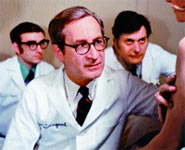Intern, then resident dermatology, Hospital University of Pennsylvania, 1936-1941; assistant professor dermatology, University of Pennsylvania Medical School, 1946-1948; assistant professor dermatology, University of Pennsylvania Medical School (Graduate School), 1946-1949; chief dermatology, Children’s Hospital Pennsylvania, 1946-1948; professor, department chairman dermatology, Jefferson Medical School, Philadelphia, 1948-1949; professor, department chairman dermatology, University Texas School Medicine, 1949-1953; chairman dermatology department, Henry Ford Hospital, Detroit, 1953-1976; chairman emeritus, Henry Ford Hospital, since 1976. Team physician Detroit Tigers Baseball Club, since 1967. Clinical professor dermatology University of Michigan School Medicine.
Member commission on cutaneous diseases AFEB, 1956-1972. Chief consultant dermatology VA, 1953-1959. Secretary-general XII Internat.Congress Dermatology, 1962.
Member American Board Medical Speciality, 1963-1992, mem.exec. committee, 1974-1976, special award, 1993. Member residency review committee for dermatology American Medical Association, 1957-1967. Member of advisory committee National Disease and TherapeuticIndex, since 1974.
Board directors, treasurer Council Medical Specialty Socs., 1976-1980, member liaison commission on graduate medical education, 1978-1983. Member Accreditation Coun. for Graduate Medical Education, 1977-1983.
Legacy
Clarence Livingood’s work ethic and sense of honor and duty to his chosen profession drove him to accomplish more than perhaps all but a few of his contemporaries. His passing coincides with the end of the century and the end of the millennium and truly marks the closing of an era for our specialty. Clarence Livingood influenced not only people—the certificate of every diplomate of the American Board of Dermatology from 1962 to 1992 bears his signature—but also profoundly influenced organizations, especially the American Board of Dermatology. Clearly these influences are his lasting legacy.

